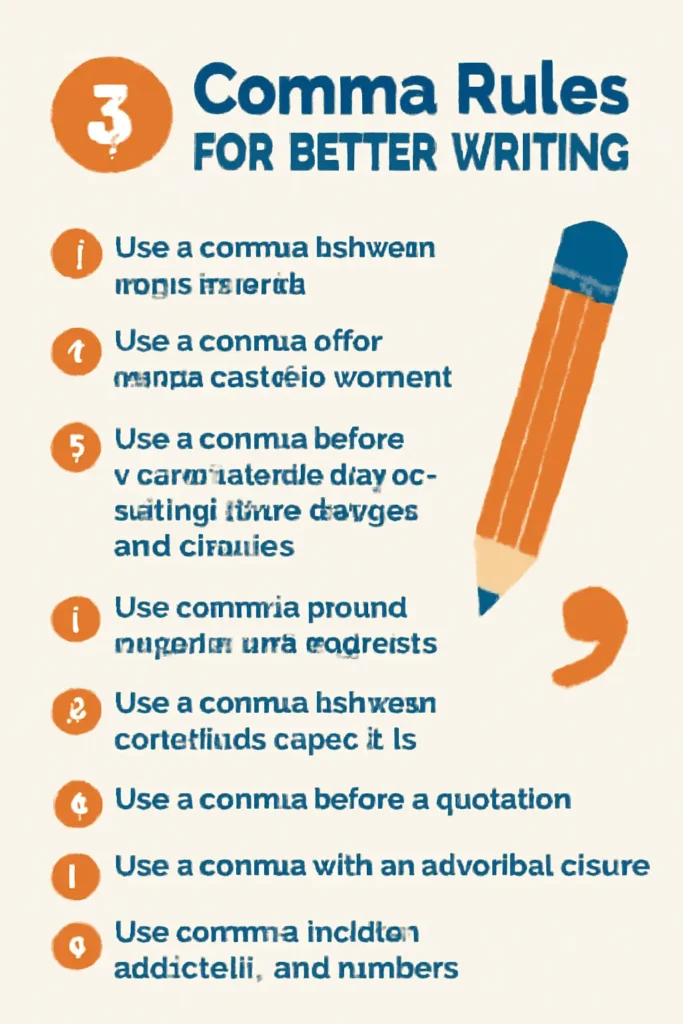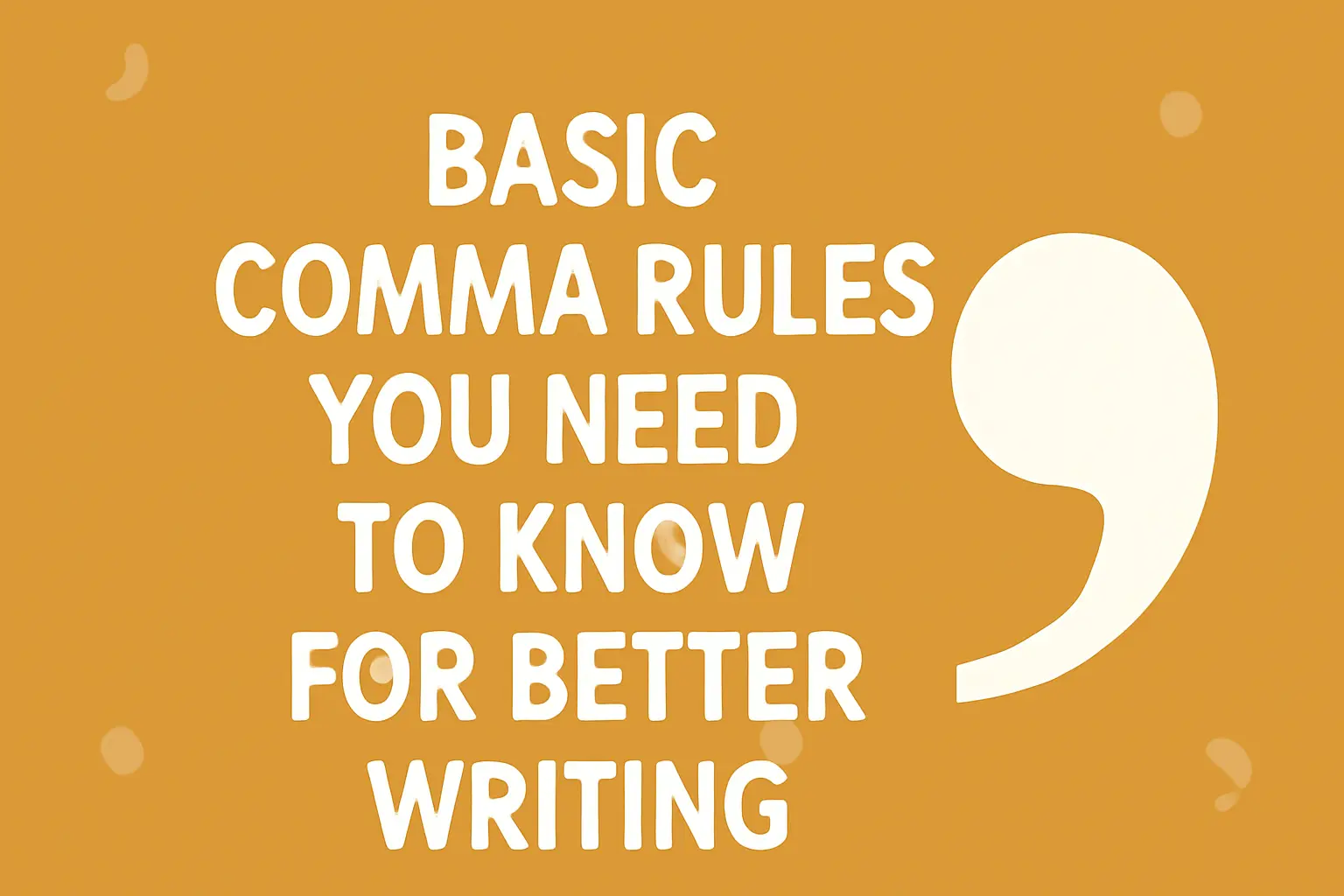Commas play a crucial role in making writing clear and easy to understand. By correctly using commas, writers can break up long sentences, separate ideas, and avoid confusion. Without commas, sentences can become jumbled, making it difficult for readers to follow the meaning. Commas help guide the reader through the text, providing natural pauses and improving readability.
Also Read: How Imagery Enhances Storytelling
Mastering comma rules can significantly enhance writing. When writers understand where to place commas, they can structure their sentences better, making them more concise and engaging. By following basic comma rules, writers ensure that their content flows smoothly, making it easier for readers to digest and enjoy. Whether in formal essays or casual blogs, knowing how to use commas effectively helps create a seamless reading experience and can make a big difference in the quality of writing.
8 Basic Comma Rules

Using Commas in Lists
Definition
Commas are essential when separating items in a list. They help break down multiple elements in a series, making the information easier to read and understand. By placing a comma between each item, writers can clearly indicate that each part is distinct while maintaining a smooth flow of ideas.
Example
For instance, consider this sentence: “I bought apples, bananas, oranges, and grapes.” Here, commas are used to separate each fruit, ensuring that the reader can easily distinguish between them. The final comma before “and” is known as the Oxford comma, which adds extra clarity, though it’s optional in some styles of writing.
Why It’s Important
Using commas in lists is crucial for clarity, especially in longer lists with several items. Without commas, the reader might struggle to identify where one item ends and another begins. Correct comma usage helps to organize thoughts in a structured manner, ensuring that your writing is clean and easy to follow. This is particularly helpful for readers skimming through the content.
Commas After Introductory Words or Phrases
Commas are used after introductory words or phrases to signal a pause before the main part of the sentence. Common introductory words include “however,” “first,” “in conclusion,” and “unfortunately.” These commas help to create a natural flow and make sentences easier to understand.
Example
For instance, in the sentence “However, I still disagree,” the comma after “however” separates the introductory word from the main clause. This pause makes the sentence clearer and improves readability.
Tip
Using commas after introductory words helps maintain smooth transitions between ideas. It’s a simple rule that enhances the clarity and structure of writing, making it more engaging for readers.
Commas in Compound Sentences
Commas are used to separate two independent clauses joined by a coordinating conjunction, such as “for,” “and,” “nor,” “but,” “or,” “yet,” and “so.” This helps clarify the relationship between the two parts of the sentence and improves readability.
Example
For example, “She likes coffee, but I prefer tea.” The comma before “but” separates the two independent clauses, making the sentence easier to read and understand.
Why It’s Useful
Using commas in compound sentences helps avoid run-on sentences, which can confuse readers. It also ensures that sentences flow smoothly, making the writing clearer and more effective for communication.
Commas Around Non-Essential Information
Commas are used around non-essential (non-restrictive) clauses, phrases, or words that can be removed without altering the meaning of the sentence. These parts provide extra details, but the sentence would still make sense without them.
Example
For example, “My brother, who lives in New York, is visiting us.” The phrase “who lives in New York” can be removed, and the sentence still makes sense: “My brother is visiting us.”
Tip
It’s important to remember that non-essential clauses can be omitted without changing the core meaning of the sentence. Using commas correctly in such cases helps avoid confusion and keeps the writing clear and concise.
Commas with Coordinate Adjectives
Commas are used with coordinate adjectives when two or more adjectives modify a noun equally. If the adjectives can be reversed or joined with “and,” a comma should be placed between them.
Example
For example, “She wore a bright, colorful dress.” The adjectives “bright” and “colorful” modify the noun “dress” equally, so a comma is used between them.
Tip
A simple rule to remember is: “If you can say ‘and’ between the adjectives, use a comma.” This ensures that the adjectives are equally modifying the noun and improves the clarity of the sentence.
Commas in Dates, Addresses, and Titles
Commas play a key role in writing dates, addresses, and titles, helping to clarify the structure of these elements and making sentences easier to read.
Examples
- Dates: “On June 25, 2025, we will meet.”
- Addresses: “Send it to 123 Main Street, Springfield, IL.”
- Titles: “Dr. John Smith, PhD, will speak at the event.”
Tip
Using commas correctly in dates, addresses, and titles helps improve clarity, especially in formal writing. They provide structure and prevent confusion, ensuring the reader can easily follow the information presented. Proper comma usage in these contexts makes the writing professional and easy to understand.
Commas with Direct Addresses
Commas are used in direct addresses to set off the name or title of the person being spoken to. This punctuation marks a clear pause, helping to identify who is being addressed in a sentence.
Example
For example, “John, please pass the salt.” The comma after “John” indicates that the speaker is directly addressing John.
Also Check: Occasion Wish Generator
Why It’s Important
Using commas in direct addresses ensures clarity, helping the reader or listener understand exactly who is being spoken to. Without the comma, the sentence could become confusing, especially if there are multiple people involved. It improves the flow and comprehension of the sentence.
Commas Before Quotation Marks
Commas should be placed before direct quotations to separate the introductory phrase from the quoted speech. This helps to clearly signal the transition from the speaker’s words to the actual quotation.
Example
For example, “I can’t believe it,” she said. The comma after “it” sets off the spoken words from the narrative part of the sentence.
Why It’s Useful
Using commas before quotation marks creates a clean, readable sentence structure, especially in dialogue. It improves the flow of the text, making it easier for readers to follow who is speaking. Proper punctuation ensures the sentence feels natural and clear.
Conclusion
To wrap up, here’s a quick recap of the 8 basic comma rules: Using commas in lists, after introductory phrases, in compound sentences, around non-essential information, with coordinate adjectives, in dates, addresses, and titles, in direct addresses, and before quotation marks. Mastering these rules will help make writing clearer and more readable.
Now that you understand these comma rules, it’s time to put them into practice! Start incorporating them into your writing to enhance clarity and flow. The more you use them, the more natural they’ll become.
Don’t forget to proofread your work for proper comma usage. A quick review can ensure your writing is polished and easy to understand. Happy writing!

